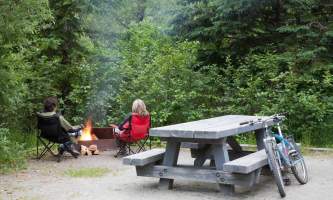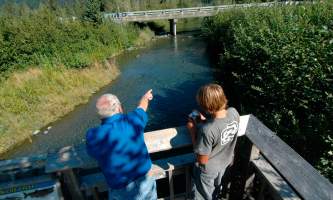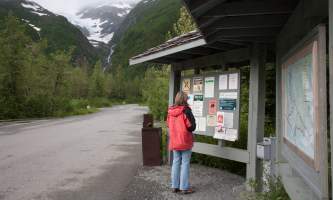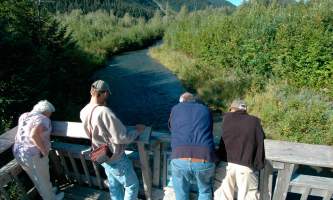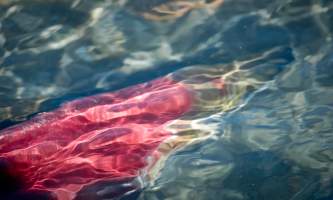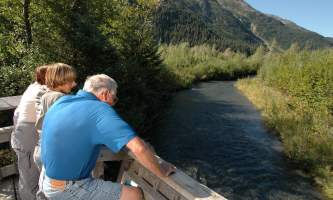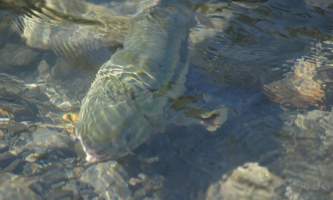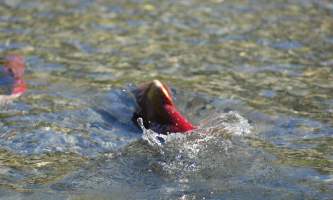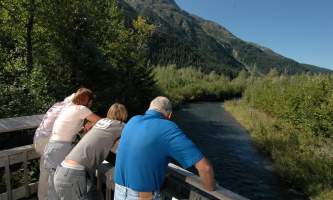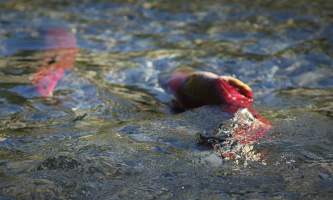Biking, fish viewing, a natural history center and a flat hike to a glacier are within easy reach of this open, spacious campground in Portage Valley at the head of Turnagain Arm in the Chugach National Forest. With 60 sites on paved loops, Williwaw is suitable for large motorhomes and offers great access to the Trail of Blue Ice — a non-motorized multi-use trail that traverses the valley floor.
The area has some of the most spectacular views in the state, with hanging glaciers and snowy massifs looming over the 14-mile isthmus that joins the Kenai Peninsula to mainland Alaska. Portage Glacier (now across the lake around the corner from sight) often produces icebergs that ground off the beach. The whole family can learn about the retreat inside the Begich, Boggs Visitor Center.
Ice Worms
For the adventurous, the Byron Glacier Trail leads to snow fields where ice worms sometimes surface after dusk. Anywhere you go, you’re surrounded by history: Before its dramatic retreat this century, Portage Glacier provided a travel route from Prince William Sound to Turnagain Arm used by Native peoples and gold rush prospectors.
The valley showcases a living ecosystem still rebounding from the ice age, with plant life ranging from lichens struggling to colonize bare rock to groves of Sitka spruce looming over a mossy rain forest.
You can’t do it all in one weekend:
- Bike and hike. The five-mile Trail of Blue Ice links all the developed sites in Portage Valley with well-maintained gravel surface and handsome bridges spanning wetlands. The campground loops are generally serene and fun for kids. The Byron Glacier Trail leads up valley (southwest of the lake) 1.4 miles to the toe of the glacier.
- View wildlife. Just outside the campground is the Williwaw Fish Viewing Platform, with an intimate look at spawning salmon from mid- to late-summer. A 1.25-mile nature trail leads along spawning streams and offers a chance to see moose, Dall sheep and bears on the mountainsides. Forest birds abound. A great place to see and hear the elusive varied thrush.
- Visit the Begich, Boggs Visitor Center. Redesigned in 2001 and open in summers, the center overlooks the lake from the terminal moraine left behind in 1914 by the retreating glacier. Award-winning displays about the region’s culture, history and natural features. $5 fee.
- Drive through the Anton Anderson Memorial Tunnel to Whittier and Prince William Sound. First blasted from solid rock by the U.S. Army during World War II for rail access to a secret military base, the 2.5-mile one-lane portal is the longest shared highway-train tunnel in North America. Travel from Bear Valley to Whittier is usually on the half-hour, depending on train traffic, and costs $13 for a passenger car. For more information on the Whittier Tunnel check here.
- Ride the 80-foot MV Ptarmigan to the face of Portage Glacier. A privately operated cruise on the lake. More info at Portage Glacier Cruise.
- Fish. Rainbow trout are stocked by the state in the 9.6-acre Alder Pond at Mile 1.5 of Portage Valley Road. Salmon and Dolly Varden can be caught in Portage Creek.
- Paddle. The valley has numerous calm ponds open to paddling, including a network of shallow channels that begin next to Alder Pond at Mile 1.5 and reach hundreds of yards into the wetland and forest. For families with experience, Portage Lake can be paddled along the north shore from the parking lot on the northeast corner to the gravel bars beneath Portage Pass. Portage Creek runs six miles from the lake through Class II conditions or less to a take-out just downstream of the Seward Highway, and is considered the easiest whitewater trip in the Anchorage area. Launch beside the visitor center below the bridge.
Doing it:
Most of the modern, paved Williwaw is remarkably open to sweeping mountain vistas, rising above a brushy forest in recovery from the occasional massive avalanche (in winter when it’s closed.) Its smaller sister campground—Black Bear—has a much different vibe. Located one mile west, Black Bear nestles on a single loop beneath a mature spruce canopy, very close to Williwaw Creek. Both offer outhouses, picnic tables, fire rings, water pump and bear-proof vaults.
Williwaw’s 60 sites range from $18 for a single and $28 for a double per night. Half can be reserved in advance through www.recreation.gov. Firewood can be sparse in the brushy, alder-dominated woods. Located at mile 4.1 of Portage Glacier Road, about one mile past Black Bear and one mile from the visitor center.
An alternative: Portage Valley RV Park. Privately run, with great online reviews, this campground is off Portage Valley Road about 1.7 miles from the Seward Highway, just past Moose Flats and Alder Pond. Take the gravel road to the south.
Weather note:
When it’s sunny and/or calm, Portage Valley may be one of the most stunning — and welcoming — destinations in the region. But check the forecast! As the low spot between the Gulf of Alaska and Cook Inlet, the valley can sometimes grow quite stormy, in effect a regional geographic venturi that channels hurricane force gusts and sideways rain.
For more info:
Here is a PDF map of Portage Valley
NWS forecast
Real time road weather at Portage Valley Road intersection with Seward Highway


